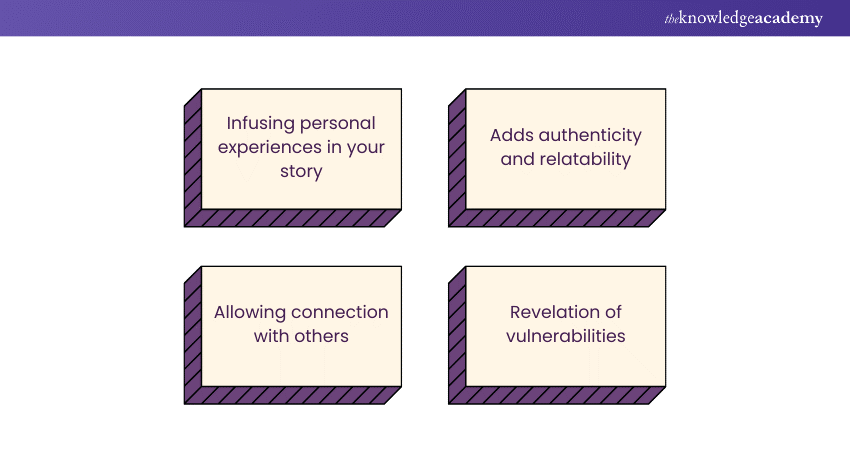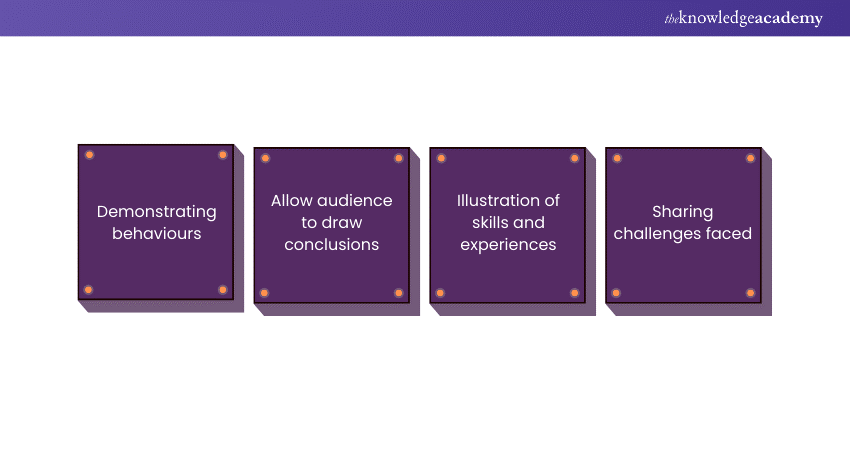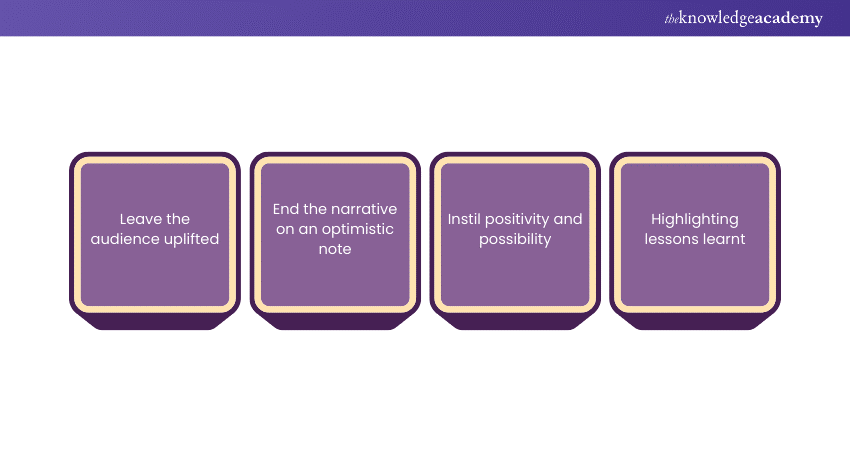We may not have the course you’re looking for. If you enquire or give us a call on +64 98874342 and speak to our training experts, we may still be able to help with your training requirements.
Training Outcomes Within Your Budget!
We ensure quality, budget-alignment, and timely delivery by our expert instructors.

Storytelling Techniques stand as powerful tools that can transform mundane information into compelling narratives. Whether in professional Presentations , networking, or casual conversations, the art of Storytelling plays an important role in successfully engaging and influencing your audience.
These techniques aren't just for writers or public speakers; they are essential skills for anyone looking to make a lasting impact in their personal and professional interactions. By employing Storytelling Techniques, you can turn abstract ideas into vivid stories, connect with your audience on a deeper level, and convey your messages more persuasively. In this blog, you will learn how Storytelling Techniques are methods and approaches used to craft and convey narratives effectively to engage, entertain, and communicate with an audience.
Table of Contents
1) Engage your audience through story immersion
2) Share a personal narrative
3) Craft anticipation and tension
4) Infuse vibrancy into characters
5) Demonstrate instead of explaining
6) Lead up to a S.T.A.R. highlight
7) Conclude with a positive message to take away
8) Conclusion
Engage your audience through story immersion
Engaging your audience through story immersion is a Storytelling Technique that draws listeners into the narrative, making them feel like they are part of the story. This technique creates a world so vivid and relatable that the audience feels emotionally invested in the outcome.
To achieve this, the storyteller uses descriptive language, sensory details, and relatable experiences that resonate with the audience. For instance, in a professional setting, when discussing a project, instead of merely stating facts, the storyteller might describe the bustling atmosphere of the team working late hours, the tension of approaching deadlines, and the collective sigh of relief and triumph at project completion.
Furthermore, this approach transforms the narrative from a series of events into an experience, allowing the audience to visualise the scenes and feel the emotions involved. It’s about painting a picture so clear that the listeners can see themselves within it, experiencing the highs and lows alongside the narrator.
More importantly, effective story immersion not only captivates the audience but also strengthens the message conveyed, leaving a lasting impact beyond mere words.
Share a personal narrative

Sharing a personal narrative is a Storytelling Technique that involves weaving personal experiences into your story. This approach is incredibly effective because it adds more authenticity and relatability that can deeply resonate with the audience.
When you share a part of your life, you're not just conveying information; you're offering a glimpse into your world, allowing others to connect with you on a human level. The power of your personal narrative lies in its ability to evoke empathy.
Moreover, by revealing your vulnerabilities, challenges, successes, and lessons learned, you create a bridge of understanding between you and your audience. It’s about transforming your experiences into a universal language that others can relate to.
For instance, in a professional context, sharing how you overcame a significant career obstacle not only demonstrates your Resilience but also inspires others who might be facing similar challenges. Moreover, personal narratives are memorable. People may forget facts and figures, but they are likely to remember your story and how it made them feel.
Craft anticipation and tension
Crafting anticipation and tension is a Storytelling Technique that builds suspense and keeps the audience engaged through uncertainty and the promise of forthcoming revelations. This method is akin to a literary cliffhanger, where the storyteller strategically withholds information or creates scenarios that leave the audience yearning to know what happens next.
Now, in a professional context, this might mean outlining a significant challenge or a high-stakes situation early in the narrative and then gradually revealing how it was navigated. The key to mastering this approach lies in understanding the balance between giving enough detail to maintain interest but not so much that it resolves the tension prematurely.
Moreover, it's about subtly ‘teasing’ the listeners with hints or raising questions that pique their curiosity. For example, a speaker might begin a presentation by mentioning a critical obstacle that threatened the success of a project but then backtrack to explain the events leading up to it, thereby creating a narrative hook that keeps the audience invested in learning how the obstacle was eventually overcome.
By crafting anticipation and tension effectively, the storyteller turns the narrative into a journey rather than merely recounting events. This approach not only makes the story more compelling but also ensures that the audience stays engaged and attentive, eagerly waiting for the resolution.
Discover your selling style! Embrace your strengths with our Sales Training and enhance your skills!
Infuse vibrancy into characters
Infusing vibrancy into characters is a Storytelling Technique that breathes life into the personalities within a narrative, making them more relatable and memorable. This approach goes beyond mere description of roles or titles, focusing instead on giving characters depth and dimension.
In a professional Storytelling context, these characters could be colleagues, clients, or even the storytellers themselves. The essence of this technique lies in the details: how these characters speak, their unique quirks, their motivations, and how they interact with their environment and with each other. For instance, instead of simply mentioning a team member, a vibrant portrayal might describe their infectious enthusiasm, systematic approach to problem-solving, or how they motivate the team. This paints a more vivid picture for the audience and helps create an emotional connection with the characters.
Moreover, infusing vibrancy into characters can also involve highlighting the dynamics and relationships between them. Showing how characters influence and are influenced by one another adds layers to the narrative, making it more engaging.
More importantly, this technique is particularly powerful, transforming the narrative from a dry account into a rich, multi-dimensional story. It allows the audience to see the characters as real people, each contributing uniquely to the storyline, thereby enhancing the overall impact and relatability of the story.
Demonstrate instead of explaining

The Storytelling Technique of demonstrating rather than explaining pivots on showing actions, behaviours, and outcomes instead of merely describing them. This method is particularly potent in conveying a message or a lesson without overtly stating it, allowing the audience to conclude based on what they observe.
In a professional context, this translates to illustrating your skills, achievements, and experiences through concrete examples rather than just asserting them. For instance, instead of asserting that you're an effective leader, you would recount a specific instance where your leadership directly contributed to resolving a crisis or achieving a goal.
This could involve describing the challenges faced, the decisions you made, the actions you took, and the results that followed. By doing so, you're not just claiming a skill but providing a clear, demonstrable instance of that skill in action.
Moreover, such a Storytelling Technique makes your story more engaging and credible. It immerses the audience in the situation, allowing them to visualise and feel the impact of your actions. Moreover, it encourages active engagement from the audience as they piece together the narrative and understand the implicit messages. Showing rather than telling enables your audience to witness your capabilities firsthand, creating a more powerful and lasting impression.
Lead change by signing up for our Innovative Thinking Training now!
Lead up to a S.T.A.R. highlight
The Storytelling Technique leading up to a 'S.T.A.R.' highlight, where 'S.T.A.R.' stands for 'Something They'll Always Remember,' is about crafting a narrative climax that leaves a lasting impression on your audience. This technique involves building up to a pivotal moment in your story that epitomises your narrative's core message or most impactful aspect.
This highlight should be memorable and emotionally resonant and should encapsulate the essence of your story. In a professional setting, a S.T.A.R. moment could be the turning point of a major project, a critical decision that led to success, or a personal achievement that profoundly impacted your career.
It's about focusing on a specific, standout event that your audience will find compelling and memorable. The build-up to this moment is crucial; it should involve setting the stage, developing the context, and gradually intensifying the narrative tension or intrigue. This journey towards the highlight not only keeps the audience engaged but also amplifies the impact of the S.T.A.R. moment when it finally arrives.
Crafting such a moment requires a thoughtful selection of details and Storytelling finesse. You want your audience to understand and feel this moment's significance. It could be how you overcame a seemingly insurmountable challenge, a moment of unexpected insight, or an instance of extraordinary teamwork.
By leading up to this highlight effectively, you deliver a story that resonates well with your audience, leaving them with a vivid, memorable takeaway that underscores your message and personal brand.
Conclude with a positive message to take away

Concluding with a positive message is a Storytelling Technique that leaves the audience with an uplifting and memorable final impression. This approach involves ending the narrative on a note of optimism, hope, or inspiration, regardless of the story's complexities or challenges. The purpose is to instil a sense of positivity and possibility in the audience, encouraging them to reflect on the story constructively.
In a professional context, this could mean highlighting a lesson learned, a success achieved, or a personal growth experienced. For instance, after narrating the challenges of a difficult project, you might conclude by emphasising the skills you developed, the knowledge you gained, or the team's resilience. This positive takeaway is crucial as it not only leaves the audience feeling inspired but also shapes how they remember and interpret the entire narrative.
Moreover, a well-crafted positive conclusion can transform an ordinary story into a source of motivation. It's about reinforcing the idea that despite hurdles, there is always something valuable to be gained. This technique is not just about ending a story on a high note; it's about imparting a lasting message that resonates with and empowers your audience.
Craft your stories smartly and effectively by signing up for our Storytelling Course now!
Conclusion
In conclusion, mastering these Storytelling Techniques can profoundly enhance your communication, making your narratives more engaging, memorable, and impactful. By skillfully weaving these methods into your stories, you can successfully captivate your audience and leave a lasting impression that underscores your professional and personal brand.
Communicate powerfully and persuasively by signing up for our Storytelling for Marketers Training now!
Frequently Asked Questions

Storytelling Techniques can transform professional presentations by making them more engaging and memorable. By weaving in elements like personal narratives, building anticipation, and creating vivid characters, presentations become more than just a transfer of information; they turn into captivating stories.

Yes, Storytelling Techniques are highly relevant in formal business settings. They provide an engaging way to convey complex ideas and strategies clearly and persuasively. Effective Storytelling can enhance communication in meetings, client presentations, and team briefings and aids in making messages more memorable and relatable.

The Knowledge Academy takes global learning to new heights, offering over 30,000 online courses across 490+ locations in 220 countries. This expansive reach ensures accessibility and convenience for learners worldwide.
Alongside our diverse Online Course Catalogue, encompassing 17 major categories, we go the extra mile by providing a plethora of free educational Online Resources like News updates, Blogs, videos, webinars, and interview questions. Tailoring learning experiences further, professionals can maximise value with customisable Course Bundles of TKA.

The Knowledge Academy’s Knowledge Pass, a prepaid voucher, adds another layer of flexibility, allowing course bookings over a 12-month period. Join us on a journey where education knows no bounds.

The Knowledge Academy offers various Sales Training Courses, including Innovative Thinking Training, Value Based Selling Training, Soft Skills Training for Sales Professionals and more. These courses cater to different skill levels, providing comprehensive insights into Understanding the Importance of Soft Skills.
Our Business Skills Blogs cover a range of topics related to Storytelling, offering valuable resources, best practices, and industry insights. Whether you are a beginner or looking to advance your Business Skills, The Knowledge Academy's diverse courses and informative blogs have you covered.
Upcoming Business Skills Resources Batches & Dates
Date
 Sales Bootcamp
Sales Bootcamp
Fri 27th Dec 2024
Fri 17th Jan 2025
Fri 7th Mar 2025
Fri 23rd May 2025
Fri 18th Jul 2025
Fri 12th Sep 2025
Fri 14th Nov 2025
Fri 12th Dec 2025







 Top Rated Course
Top Rated Course



 If you wish to make any changes to your course, please
If you wish to make any changes to your course, please


